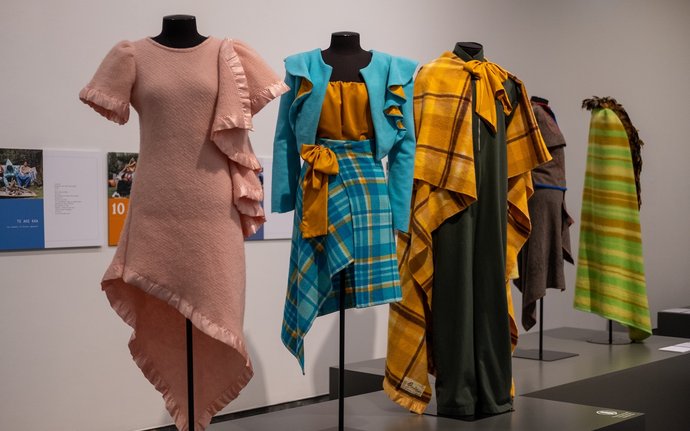Fashion activist wants you to Dress Up & Dance: Jeanine Clarkin
29 Feb 2024
This article first appeared in The Post, 29 February 2024

This article first appeared in The Post, 29 February 2024

Waiheke Island designer Jeanine Clarkin (Ngāti Hako, Ngāti Pāoa, Ngāti Ranginui, Ngāti Raukawa) is a champion of indigenous Māori fashion and her work has been described as fashion activism. Clarkin’s garments feature alongside other contemporary Māori artists – Noa Blanket Co and Mataaho Collective – in Paraikete Threads. The exhibition explores the stories, histories and knowledge systems embedded in the blanket and on the opening day, Clarkin is hosting a special event for all ages, Dress Up and Dance with Jeanine Clarkin.
My mother, aunties and grandmother all sewed, so I grew up sewing; I was seven when I got my Brownie badge. My parents ran recycling businesses – visionary in those days. You got your clothes from an opp shop, swapped them with your cousins or made them yourself.
I initially wanted to be a hairdresser, only because I loved the clothes they wore, and I didn’t realise that ‘designer’ was an option. I started to get a bit of a name for the clothes I made and wore out nightclubbing and after moving to Raglan and training at Eva Rickard’s Kokiri Centre, I found my way to fashion school at Wellington Polytechnic (now Massey University). In 1994, I set up my own label Jeanine Clarkin Design and met Buck Nin. My pathway to Māori design opened up – providing young urban Māori with garments they could wear every day to express who they were. I’m proud to be Māori, and I initially made really loud clothes that only Māori would wear. I’d sell my clothes at markets and festivals then people started to buy them to take overseas as gifts, and it grew from there. I’ve always wanted my tāniko print fabric to be like the Burberry fabric or like a check, just a classic.
I used to go to family parties and give the aunties $20 each, and they’d go opp shopping for me. Then other people got into it, and the prices went up. I have my favourites: grey with the red blanket stitch, grey with the red stripes, white hospital blankets with mint stripes and the really bright coloured ones.
You’ll see the best of what I’ve shown overseas, including at the Musée du Quai Branly as part of their Oceania exhibition in 2019. There’s sexy hotpants, menswear, women’s coats and a woollen dress worn by Dr Hinemoa Elder at her investiture. Each piece talks about a time and place in society.
There are many analogies around the blanket and their connection with colonisation, and I like to think that I am ‘blanket banking’– like land for blankets; blankets are currency. They used to be cheap and now are coveted, expensive and becoming a scarce resource. Blankets have been used in exchange for land, so there’s the idea around this unbalanced exchange.
I’m also interested in sustainability and the circular economy, and the exhibition has messages about reuse and reducing what goes to landfill – once these garments are worn beyond the last repair, they can be composted.
I want people to dress up and have fun, perhaps take on the persona of a model, and I’m well known for getting people moving. People are transformed by the garments they wear – dressing up can change them and bring out their wairua. Everyone has a response to blankets – whether that’s “Oooh they’re scratchy” or a memory of a blanket in the back of the car in case of an emergency. But my blankets are colourful, fun and healing.
